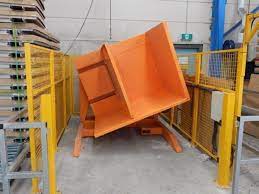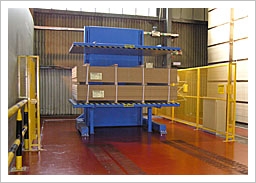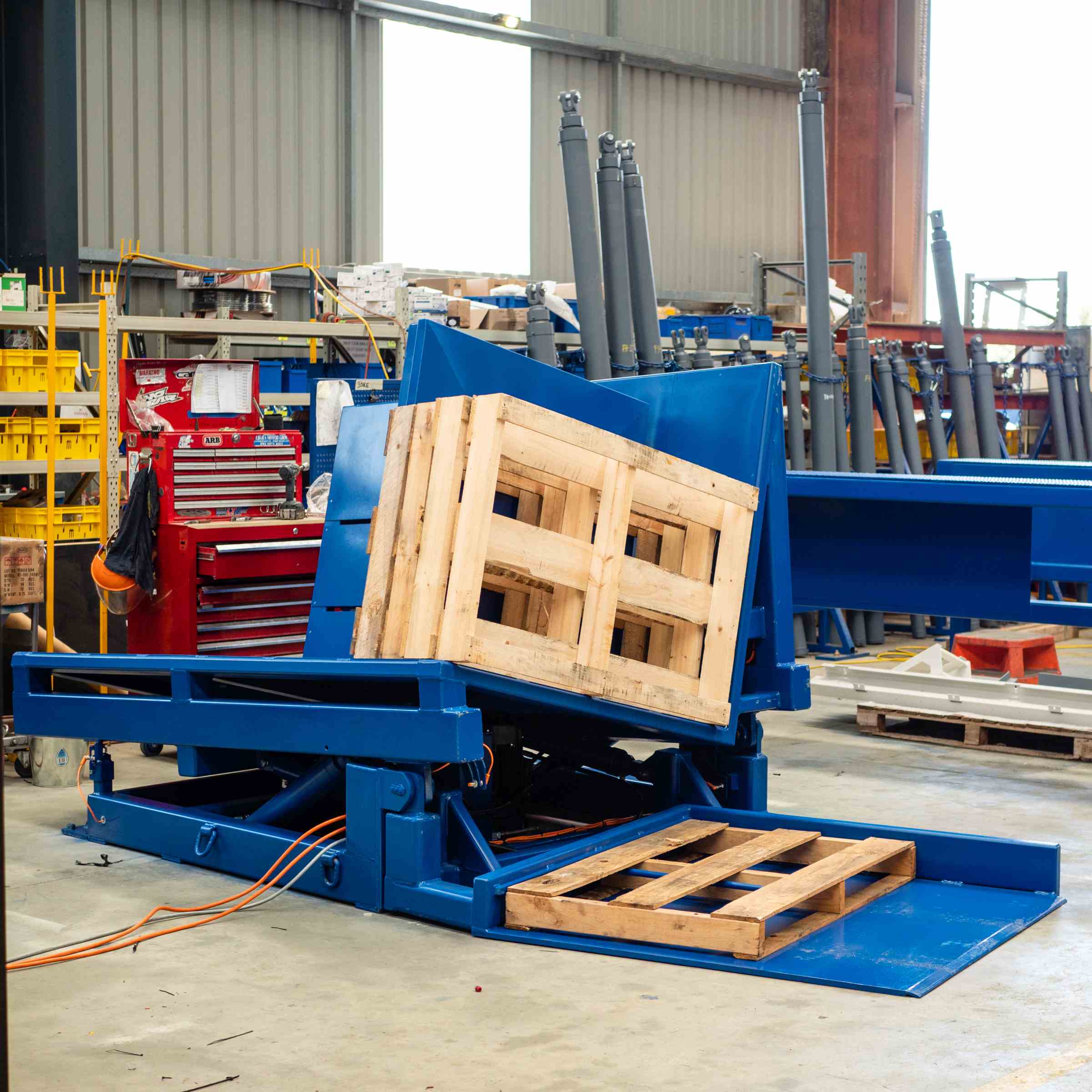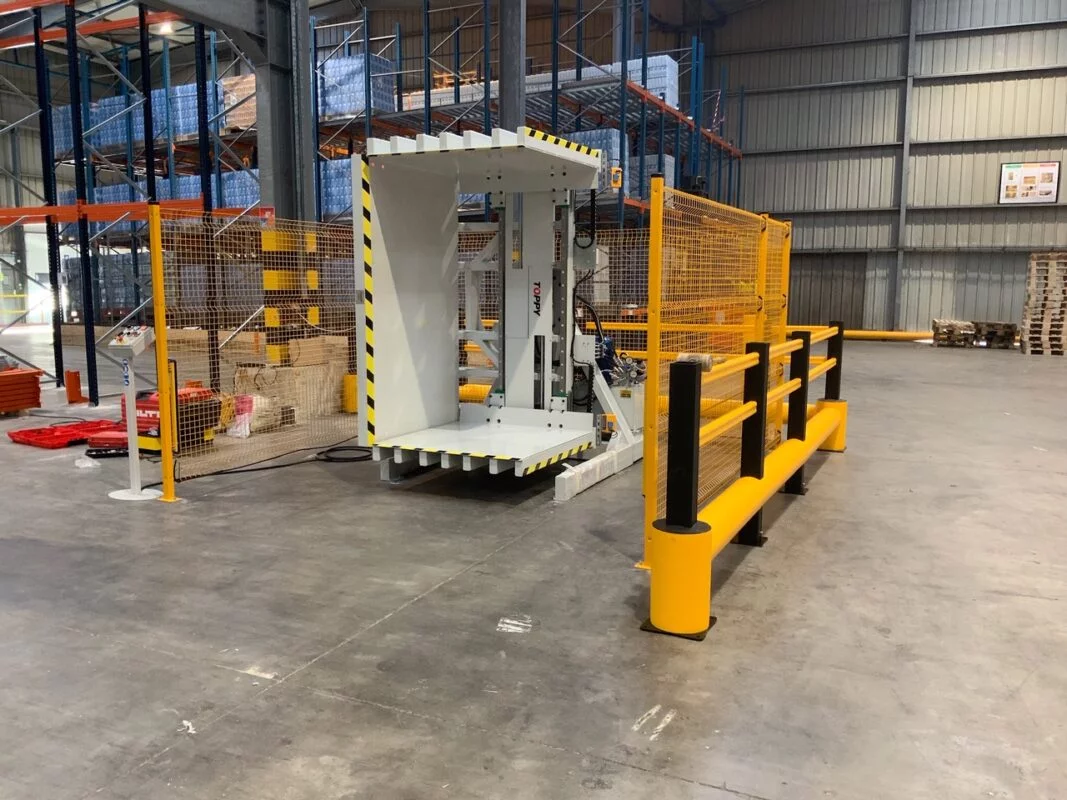Is Your United Kingdom Factory Struggling with Brexit-ready Pallet Change Compliance? Try a Pallet Changing Machine
Are you managing a factory in the United Kingdom? Since Brexit, you've likely faced a whole new set of rules and logistical challenges. One of the most persistent headaches is pallet compliance for goods heading to the EU. Using the wrong type of wooden pallet can lead to your shipments being rejected at the border, causing expensive delays and damaging relationships with your European customers. You might be resorting to manually swapping goods from your standard internal pallets to special heat-treated ones for export. This process is slow, physically demanding for your team, and creates a major risk of product damage and worker injury. It’s a frustrating bottleneck in your dispatch area, adding pressure to an already complex operation. But there is a much better, safer, and more efficient way. A dedicated pallet changing machine can automate this entire task, guaranteeing compliance, protecting your products, and dramatically speeding up your logistics workflow.
Yes, a pallet changing machine is the most effective solution for UK factories facing Brexit-related pallet compliance challenges. It automates the transfer of goods from one pallet to another. This ensures you always use the correct ISPM 15-compliant pallets for export. It also eliminates manual labor risks and prevents costly shipping delays at the border.

I've spent my entire career in the packing machine industry, from working on the factory floor to building my own company, SHJLPACK. I’ve seen these exact challenges firsthand. Many factory managers I speak with feel trapped between rising operational costs and a growing list of complex regulations. They know they need to change, but the path forward isn't always clear. The good news is that understanding the specific details can reveal a straightforward solution. Let's break down exactly what these new rules mean for you and how a pallet changer can transform this compliance headache into a competitive advantage for your UK factory.
How does Brexit affect pallet regulations for UK factories?
Are you still uncertain about the specific pallet rules your UK factory must follow for every shipment to the EU? The post-Brexit regulations can seem complicated and difficult to navigate, leaving you worried about accidental non-compliance, potential fines, or even having your goods turned away at customs. A single mistake, like sending out a standard domestic pallet, can cause a chain reaction of problems. Your shipment gets stuck, your delivery schedule is thrown into chaos, and your European client is left waiting. The constant fear of this happening adds a layer of stress to your daily operations. The solution lies in a clear understanding of the ISPM 15 standard. Let’s clarify what these rules mean for your pallets and how you can ensure every shipment leaving your UK facility is perfectly compliant.
After Brexit, all wood packaging material, which includes wooden pallets, moving between the United Kingdom and the European Union must be heat-treated and marked according to ISPM 15 standards. This international rule is designed to prevent the spread of pests and plant diseases. This means your typical UK domestic wooden pallets are almost certainly non-compliant for export to the EU, forcing you to switch your goods to a compliant pallet before they can be dispatched.

Deeper Dive: The Reality of ISPM 15 Compliance
Before Brexit, the UK was part of the EU's single market, so these phytosanitary rules did not apply to trade between member states. It was a seamless process. Now, the UK is treated as a "third country," which means it must adhere to the same international standards as countries like the USA or China when trading with the EU. This change fundamentally alters a key part of your logistics chain.
So, what exactly makes a pallet compliant? The core of ISPM 15 is treatment. The wood must be treated to eliminate any potential pests. The most common method by far is Heat Treatment (HT). This process requires the wood core to be heated to a temperature of 56°C for a minimum of 30 continuous minutes. After treatment, the pallet must be stamped with an official, globally recognized mark. This mark includes the IPPC (International Plant Protection Convention) symbol, a two-letter country code (e.g., GB for Great Britain), a unique code for the treatment provider, and the treatment code itself (HT).
This creates a significant operational challenge for many UK factories. For years, you have likely used a mix of pallets for your internal warehouse movements and domestic deliveries. These are often cheaper, untreated wooden pallets that are perfectly fine for use within the UK. Now, you must maintain a separate inventory of more expensive, ISPM 15-compliant pallets exclusively for EU exports. This leads to the critical question: what is the safest and most efficient way to transfer your finished goods from an internal, non-compliant pallet to a clean, compliant export pallet right before shipping? This is the new reality of logistics in a post-Brexit world.
| Feature | Domestic UK Wooden Pallet (Often Non-Compliant) | ISPM 15 Compliant Export Pallet |
|---|---|---|
| Treatment | Typically untreated | Must be Heat Treated (HT) |
| Markings | None required for domestic use | Must have the official IPPC/ISPM 15 stamp |
| Cost | Generally lower | Higher due to treatment and certification costs |
| Use Case | Internal logistics, UK domestic shipping | Required for export to the EU and many other nations |
| Risk if Used for EU Export | High: Shipment rejection, fines, delays, damaged client trust | Low: Ensures smooth customs clearance and compliance |
What are the manual pallet changing risks you're overlooking?
Your team is currently swapping goods from one pallet to another by hand. On the surface, it might seem like a straightforward, low-cost way to solve the compliance problem. But are you truly aware of the hidden dangers and accumulating costs associated with this manual process? Every time a worker bends down to lift a heavy box, there is a risk of a serious back injury, which can lead to workers' compensation claims, long-term absences, and lost productivity. During the manual transfer, products get dropped, packaging gets torn, and goods get damaged. The whole process is painfully slow, creating a major bottleneck in your dispatch area that delays your trucks and frustrates your entire logistics team. These hidden costs are eating into your profits every single day. By recognizing these risks clearly, you can build a strong case for a much better method.
The primary risks of manual pallet changing are significant and costly. They include a high probability of worker injury from repetitive and heavy lifting, frequent product damage from drops or unstable restacking, major operational inefficiencies that cause shipping delays and detention fees, and potential cross-contamination from transferring goods on a dirty factory floor.

Deeper Dive: The Hidden Costs of Manual Handling
As an engineer, I am trained to look at systems and identify points of failure. Manual pallet swapping is a system fraught with failure points that cost businesses more than they realize. Let's move beyond the obvious and look at the real-world impact.
The most critical risk is to your people. The Health and Safety Executive (HSE) in the UK has extensive regulations on manual handling for a reason: it's a leading cause of workplace injuries. Musculoskeletal disorders, particularly back injuries, account for a massive number of lost workdays. I once visited a client's factory where their dispatch department was severely handicapped because two of their most experienced workers were on long-term sick leave with back strain. The cause? Repetitively lifting heavy boxes to swap pallets. The cost to that business wasn't just sick pay; it was the cost of temporary staff, reduced department morale, and the very real possibility of a personal injury claim, which can run into tens of thousands of pounds.
Next is the integrity of your product. When your team has to unstack an entire pallet load of goods and then restack it on a new pallet, the potential for damage is enormous. Boxes at the bottom can be crushed, packaging can be ripped, and the contents can be broken or compromised. If you are shipping high-value electronics or fragile items, a single damaged pallet can wipe out the profit margin for the entire shipment. For industries like food, beverage, or pharmaceuticals, the risk is even greater. Manual handling at floor level, where dust and debris accumulate, introduces a serious risk of contamination. This is not just a quality issue; it's a major compliance failure that can lead to product recalls and severe reputational damage.
Finally, consider the operational bottleneck. A manual process is inherently slow and inconsistent. How many pallets can two workers safely swap in an hour? Perhaps ten if they are working at maximum capacity. This slow, manual step chokes your entire supply chain. Production might be efficient, but if goods are piling up waiting to be put on the right pallet, the whole system grinds to a halt. This leads to trucks waiting in the yard, drivers on the clock racking up detention fees, and missed delivery slots.
| Task | Manual Pallet Change (2 Workers) | Pallet Changer Machine (1 Operator) |
|---|---|---|
| Time per Pallet | 5-10 minutes | 1-2 minutes |
| Pallets per Hour | 6-12 | 30-60 |
| Worker Injury Risk | High (back strain, repetitive motion) | Very Low |
| Product Damage Risk | Moderate to High | Very Low |
| Process Consistency | Low (Varies with worker speed/fatigue) | High (Consistent cycle time every time) |
How can a pallet changing machine improve your operational efficiency?
Do you constantly feel like your dispatch department is playing catch-up, struggling to keep pace with the output from your production lines and the pressure of tight shipping deadlines? This non-stop rush often leads to costly errors, unplanned overtime for your staff, and a high-stress work environment. You know there must be a more streamlined way to manage the flow of goods from your factory floor to the delivery truck, especially now with the mandatory extra step of swapping pallets. A pallet changing machine is like a direct injection of efficiency into your logistics workflow. It automates what is likely the slowest and most labor-intensive part of your dispatch process, creating a smooth, fast, and predictable flow that eliminates bottlenecks and reduces operational stress for everyone involved.
A pallet changing machine drastically improves operational efficiency by cutting the time required to swap a pallet from over five minutes manually to under two minutes automatically. This immediately increases throughput, which means you can ship more goods per hour. It also reduces direct labor costs, minimizes expensive product damage, and allows for seamless integration with other automated warehouse systems like conveyors and Automatic Guided Vehicles (AGVs).

Deeper Dive: Unlocking a More Productive Workflow
From my journey of building SHJLPACK, I learned that the most successful factories are the ones that relentlessly pursue efficiency. They don't just work harder; they work smarter by investing in technology that removes friction from their processes. A pallet changer is a prime example of this philosophy.
The most immediate and obvious benefit is speed. As we've discussed, a machine can process pallets at a rate that is simply impossible for a manual team to match safely. Imagine being able to process 30, 40, or even 60 pallets per hour with a single operator. This means you can clear the backlog in your dispatch area quickly and consistently. Trucks can be loaded on schedule, which helps you avoid costly detention fees from haulage companies. This newfound speed creates valuable capacity. You can handle a sudden surge in orders or increase your overall output without needing to hire more staff for the dispatch area. For a UK factory looking to grow its export business into the EU, this additional capacity is a massive competitive advantage.
This leads to the next key improvement: labor optimization. This isn't about replacing your valuable workers. It's about reallocating them to higher-value tasks where their skills and judgment are better used. Instead of having two people engaged in strenuous, repetitive, and low-skill lifting, you can have one operator manage the pallet changing machine. The other worker can be reassigned to crucial tasks like performing final quality control checks, preparing shipping documentation, or managing inventory levels. You are using your human capital more intelligently and creating more engaging roles for your team. This is a core strategy I have seen in every successful factory I have helped. They automate the mundane to free up their people to solve problems.
Finally, think about integration. A standalone pallet changer is a powerful tool. But its true potential is realized when it becomes part of a larger automated system. It can be placed at the end of a conveyor line coming from production. Once the pallet is swapped, the goods can then proceed on another conveyor to an automatic stretch wrapper and then directly to the loading bay. This creates a "no-touch" end-of-line packaging and dispatch solution. This is the direction modern manufacturing is heading, and it's how you build a factory that is resilient, efficient, and ready for the future.
| Workflow Step | Manual Process | Automated Process with Pallet Changer |
|---|---|---|
| 1. Goods Arrive at Dispatch | Pallet placed on floor by forklift. | Pallet moves on conveyor to changer. |
| 2. Pallet Swap | 2 workers manually destack/restack goods. | Machine automatically inverts/swaps pallet. |
| 3. Post-Swap | Manual restacking, potential wrapping. | Goods move on conveyor to automatic wrapper. |
| 4. To Loading Bay | Forklift moves pallet to truck. | Pallet moves on conveyor to loading bay. |
| Total Time | 15-20 minutes per pallet | 3-5 minutes per pallet |
My insights on choosing the right pallet changer
You are now convinced that a pallet changing machine is the right move for your factory. But this leads to a new and equally important question: which one should you choose? There are several different types of machines, each with different capacities, features, and footprints. Making the wrong choice could be a costly mistake that you have to live with for years. You might worry about investing in a machine that is too slow for your throughput needs, too complex for your team to operate safely, or unable to handle your specific types of products. The fear of making a poor investment decision can lead to analysis paralysis, keeping you stuck with your current inefficient and risky manual process.
As an engineer who has spent a career designing, building, and implementing these very systems, I can help you navigate these choices. By focusing on a few critical factors, you can confidently select the perfect pallet changing machine that will become a reliable workhorse for your UK factory for years to come. The key to choosing the right pallet changer is to first assess four critical factors: your load characteristics (weight, dimensions, stability), your required throughput (how many pallets per hour you need to process), your available operational space and existing workflow (standalone or integrated), and the level of automation you desire (from a simple push-button operation to a fully integrated, "lights-out" system). A thorough analysis of these points will guide you to the ideal model for your specific needs.

Deeper Dive: An Engineer's Guide to Selection
This is the part of the process I enjoy most—helping clients find the perfect fit. It's not about selling a machine; it's about engineering a solution. Let’s look at the main types and the questions you must ask.
First, there's the Pallet Inverter. This is the most common and often most robust type. The machine uses a clamping mechanism to secure the entire load, then rotates it 180 degrees. The old pallet is now on top, where it can be easily removed and replaced with a new, compliant pallet. The machine then rotates the load back 180 degrees. This method is incredibly fast and effective. It's best for stable, durable loads like sacks of material, heavy boxed goods, or sealed drums. A key side benefit is that the process also neatly squares up a load that may have shifted during transit. However, it is not suitable for products that are fragile, orientation-sensitive (e.g., must be "this way up"), or top-heavy.
Second, you have the Pallet Exchanger. This machine offers a more gentle approach. Instead of inverting the load, it clamps the products from the sides and lifts the entire stack just enough for the old pallet to be slid out from underneath. A new pallet is then positioned below, and the machine gently lowers the product stack onto it. This is the ideal solution for more delicate loads, such as open-top boxes of fruit, trays of bottles, or products that cannot be turned upside down for any reason. The trade-off is that this process is typically a bit slower than a full inversion, and it may not be suitable for very heavy or irregularly shaped loads that are difficult to clamp securely from the sides.
Before you even discuss price with a supplier, you need to have a detailed technical conversation. Here are the crucial questions I advise every one of my clients to ask:
- What is the machine's maximum load capacity in terms of both weight and dimensions (length x width x height)?
- What is the realistic, sustained cycle time? Don't accept a theoretical number; ask to see a video of it in operation with a similar load.
- What are the standard safety features? Look for safety cages, light curtains at the entrance, and clearly marked emergency stop buttons.
- How can this machine be integrated with our existing line? Discuss conveyor heights, control systems, and communication protocols.
- What is the recommended maintenance schedule, and what is the availability of spare parts and technical support here in the UK? Post-Brexit, having a supplier with reliable local support or a solid logistics plan for parts is absolutely critical.
| Factor | Pallet Inverter (180° Turn) | Pallet Exchanger (Side Clamp) | Your Specific Requirement |
|---|---|---|---|
| Load Type | Stable, robust, boxed goods, sacks, cans | Fragile, top-heavy, open boxes, bottles | [Define your typical product load here] |
| Speed | Faster (Typically 40-60 pallets/hr) | Slower (Typically 20-30 pallets/hr) | [Define your target throughput here] |
| Handling | More aggressive (full 180° rotation) | Very gentle (lift, hold, and lower) | [Define your product's handling needs] |
| Footprint | Varies, can be more compact for basic models | Can require a larger operational area | [Measure your available factory floor space] |
| Ideal For | High-volume logistics, building materials | Food & beverage, pharma, sensitive electronics | [Define your industry and application] |
My final insight is this: don’t just buy a machine from a website or a catalog. Work with a supplier who wants to be your partner. Find someone who asks you these critical questions and genuinely wants to understand your unique process. That is the core of our philosophy at SHJLPACK. We are dedicated to providing a total solution, not just selling a piece of equipment.
Conclusion
A pallet changing machine solves Brexit compliance, boosts efficiency, and protects your staff. It is a strategic investment for any modern UK factory, ensuring a strong and competitive future.



